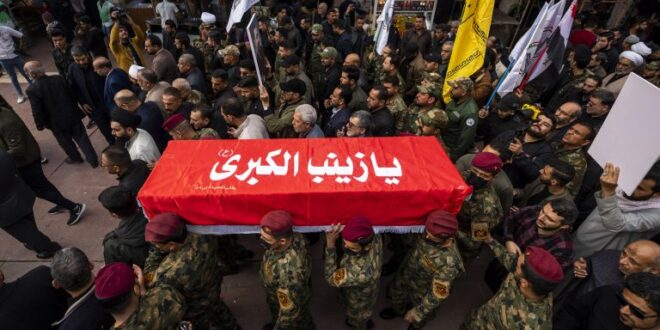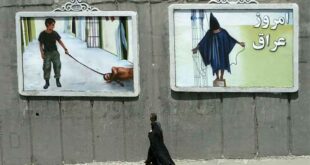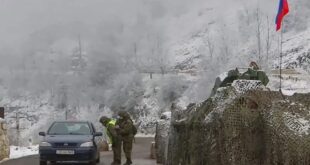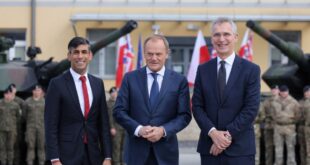Syria is emerging as a potentially significant new front as the Israel-Hamas war threatens to expand into a region-wide conflict.
The regime of Syrian President Bashar Al Assad provides a permissive environment for Iran, Iran-backed militia fighters, and Palestinian militants to launch attacks on Israel, prompting an escalating Israeli response.
The Syrian military will not join a war against Israel because of the threat posed by armed rebel groups that still operate in large parts of the country.
Assad is using the Hamas-Israel war to improve his domestic and regional political position.
As of the end of 2023, fighting across the Israel-Syria frontier is escalating as Israel, amidst its ongoing battle against Hamas, tries to counter the extensive Iranian presence and influence in Syria. Since early December, Israel has sought to send Tehran pointed warnings to abandon its efforts to pressure the IDF on multiple fronts. Israel has increased the frequency of its strikes on Syria’s airports in Damascus and Aleppo, which serve as transshipment points for Iran to offload weapons bound for Hezbollah. Israel has also been striking outposts in Syria’s rural areas as Iran spreads out its allied militia forces in the country. The Golan Heights has become an intense arena of competition, with Shia militias sending drones and missiles over the territory. Israel has responded to Palestinian militant artillery and other attacks launched from Syria largely with counterbattery fire, but it is the presence and operations of Iran’s Islamic Revolutionary Guard Corps-Qods Force (IRGC-QF) and Iran-backed militants that are now attracting more forceful Israeli action in Syria. Israel has long viewed Iran as a potential existential threat and, meeting Israeli expectations in the context of the October 7 Hamas attack, Iran has unleashed its Shia allies in Syria, Iraq, Yemen, and Lebanon to attack Israeli targets and interests, as well as those of Israel’s main backer, the United States. Since October 17, pro-Iranian militias have conducted more than 100 attacks on bases in Syria and Iraq used by U.S. forces in their effort to prevent the Islamic State organization from regrouping. Another Iran ally, the Houthi movement in Yemen, has been attacking commercial shipping in the southern Red Sea and launching missiles and armed drones at U.S. and allied naval vessels as well as towards Israel. Lebanese Hezbollah is tying down Israeli forces through cross-border attacks.
It is difficult for Iran’s proteges, including Palestinian militants, to conduct more than harassment attacks against Israel from Syrian territory. But Iran’s extensive presence in Syria has the potential to significantly complicate the Israel Defense Forces (IDF) campaign against Hamas, particularly in the event Hezbollah joins the war full force. For nearly four decades, the Assad family regime, now led by President Bashar al-Assad, has been the closest Arab government ally of Iran and has served as the key transshipment route for Iran to arm its key non-state ally, Lebanese Hezbollah, with a large arsenal of advanced rocket, missile, anti-tank, and other weaponry. The Assad regime’s centrality to Iran’s forward defense strategy, referred to often as its “unity of fronts” doctrine, explains why Iran and Hezbollah intervened militarily in 2013 to help Assad suppress a nationwide armed rebellion that nearly toppled his regime. In order to continue to assist Assad and to diversify its supply routes to Hezbollah, Iran has built a large military infrastructure in Syria, including production facilities, arms warehouses, and a network of militia forces reporting to IRGC commanders in Syria.
On December 25, Tel Aviv escalated significantly against Tehran by striking and killing the IRGC-QF’s top commander in Syria, Sayyed Reza Mousavi, during his meeting with Iran’s ambassador to Syria. The action prompted days of mourning processions in Iran and Shia-dominated cities in Iraq. Equating the killing to the January 2020 U.S. drone strike that felled the revered IRGC-QF commander Qasem Soleimani, Iranian leaders threatened Israel with retaliation and revenge. In an address at Mousavi’s high-profile funeral in Tehran, IRGC Commander-in-Chief Hossein Salami described Mousavi as a longtime close companion of Soleimani who helped the slain commander build the IRGC-QF into a major regional actor pivotal to Iran’s national security. Israel continued to challenge Tehran by conducting another significant strike, on December 28, that reportedly killed 11 high-ranking IRGC-QF officers at Damascus airport. Other Israeli strikes that day targeted sites in southern Syria and near Damascus. On December 29, according to Syrian media, an air strike apparently conducted by Israel hit nine IRGC-run locations in the city of Al Bukamal in eastern Syria, including a headquarters, an arms depot, and a convoy crossing the Iraqi border into Syria. The attack was said to result in the deaths or serious injury of at least 20 Iran-backed militia fighters.
At the same time, despite its history and the Arab nationalist ideology of its regime, Syria’s government has remained largely sidelined in the Hamas-Israel war. Syria joined with Egypt in 1973 in a determined but failed effort to recapture territory taken from both key Arab states in the 1967 Arab-Israeli war. Unlike Egypt and Jordan, Syria – led by members of the Assad family and its core Alawite community political base – has consistently disavowed recognition of or any formal peace agreements with Israel, opting instead to abide by a U.S.-brokered armistice that ended the 1973 conflict. Since the early 1970s, Syria’s regimes have hosted a wide array of armed Palestinian rejectionist factions, such as the Popular Front for the Liberation of Palestine – General Command (PFLP-GC). Syria has also hosted Hamas leaders over the years despite the Damascus government’s secular bent and the Alawite community’s adherence to a sect of Islam akin to Shiism. But Syria’s government has not committed – and is unlikely to commit – government forces to launch attacks on Israel in sympathy with Hamas or at the instigation of Tehran. The Syrian Arab Army (SAA) has been significantly depleted by more than a decade of fighting against an armed rebellion that erupted in early 2011 and remains dependent upon air strikes and advice from Russia and Iran. Government opponents remain armed and active in much of northern Syria, and Islamic State fighters continue to battle regime forces in various parts of Syria. Anti-government demonstrations have erupted in parts of the south throughout 2023. The Assad regime undoubtedly calculates that direct Syrian participation in the Hamas-Israel war would prompt Israeli action that could decisively weaken the military’s ability to protect Damascus’ grip on power. Although Israeli strategists are concerned about the uncertainties of a successor regime in Syria, many Israeli leaders would welcome the accession to power of a Syrian leader unbeholden – or even opposed – to Tehran.
For now, Assad appears content to serve as an instrument of Iranian strategy while remaining on the sidelines of the battle. He is instead using the Israel-Hamas war to discredit his domestic opposition and advance his reintegration into the Arab fold. Assad attended the December 11 joint Organization of Islamic Cooperation-Arab League emergency summit in Riyadh on the Mideast crisis. At the summit, which marked the second time that Assad addressed the Arab League since Syria’s readmission to the group in May, he urged the Arab states to take concrete action against Israel. Indirectly criticizing Arab leaders that have participated – or are considering participating – in the U.S.-brokered Abraham Accords normalization process with Israel, Assad declared that no country in the region should be engaging Israel in any “political process” until Israel agrees to a ceasefire in Gaza. His stance appears to represent Damascus’ calculation that the war has shifted Arab populations, including in Syria, decisively in favor of resistance to Israel – a constant hallmark of Syrian policy. The regional public attitude shift has given Assad new ammunition with which to paint his armed oppositionists as pro-American and out-of-touch proponents of Arab-Israeli peace. Assad also has accused global diplomats of a double standard for accusing his government of war crimes against his domestic opponents while failing to hold Israel to account for causing thousands of deaths among Gaza civilians. Still, decisions about the degree to which Syria becomes a major arena in an expansion of the Israel-Hamas war will likely be made in Iran and Israel rather than in Damascus.
 Eurasia Press & News
Eurasia Press & News




